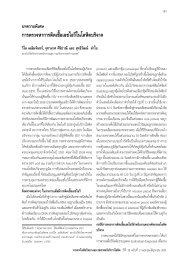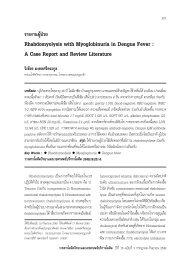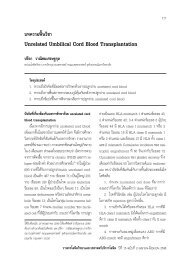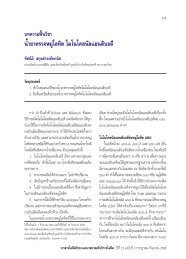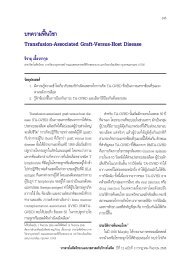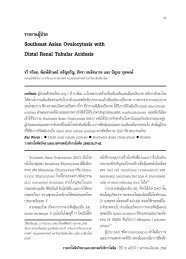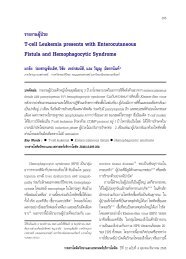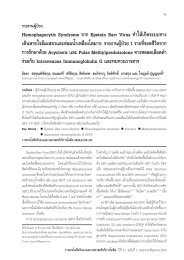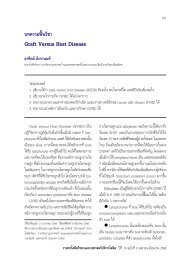Emergency Transfusion of Group O Red Blood Cells in Additive ...
Emergency Transfusion of Group O Red Blood Cells in Additive ...
Emergency Transfusion of Group O Red Blood Cells in Additive ...
You also want an ePaper? Increase the reach of your titles
YUMPU automatically turns print PDFs into web optimized ePapers that Google loves.
232 วราภรณ สุรัตนรังสรรค และคณะ<strong>Emergency</strong> <strong>Transfusion</strong> <strong>of</strong> <strong>Group</strong>O <strong>Red</strong> <strong>Blood</strong> <strong>Cells</strong><strong>in</strong> <strong>Additive</strong> SolutionVaraporn Suratanarungsun, Sasitorn Bejrachandra, Wipanee Leehaphaiboonsakun,Kanchana Outrakoolpoonsu, Laksami Kalanchai and Viroje ChongkolwatanaDepartment <strong>of</strong> <strong>Transfusion</strong> Medic<strong>in</strong>e, Faculty <strong>of</strong> Medic<strong>in</strong>e Siriraj Hospital, Mahidol UniversityAbstract: In urgent situations, even us<strong>in</strong>g uncrossmatched blood may havea delay due to transportation, specimen process<strong>in</strong>g and crossmatch procedure. We therefore have set upa program <strong>of</strong> giv<strong>in</strong>guncrossmatched blood which is group O, Rh positive red cells suspended <strong>in</strong> additive solution (O-ASblood) for extreme emergencies. From 1999 to 2003, 104 patients (av. 20.80 cases/year) at the emergencyunit, Department <strong>of</strong> Surgery, Siriraj Hospital were transfused with 246 units <strong>of</strong> O-AS blood (av. 2.37units/case). From 2001 to 2003, 15 patients (av.5 cases/year) at the labour room, Department <strong>of</strong> Obstetrics and Gynaecology were transfused with 23 units <strong>of</strong> O-AS blood (av. 1.53 units/case). The number<strong>of</strong> blood used <strong>of</strong> these two groups were 38.86 % and 8.98 % <strong>of</strong> the provided blood, respectively. Therisks <strong>of</strong> nonO blood type patients who received O-AS blood <strong>of</strong> these two groups were 72.11% and 40%,respectively. In this study, Rh negative blood type was not found but anti-Le b was identified <strong>in</strong> onepregnant woman. Fortunately, the blood transfused was Le (a+b-) phenotype. Furthermore, none <strong>of</strong> thetransfusion reaction was reported <strong>in</strong> nonO or unknown blood type who received O-AS blood .Key Words : • <strong>Emergency</strong> • <strong>Transfusion</strong> • O-AS bloodThai J Hematol Transf Med 2005;15:223-32.Thai Journal <strong>of</strong> Hematology and <strong>Transfusion</strong> Medic<strong>in</strong>e Vol. 15 No. 4 October-December 2005




